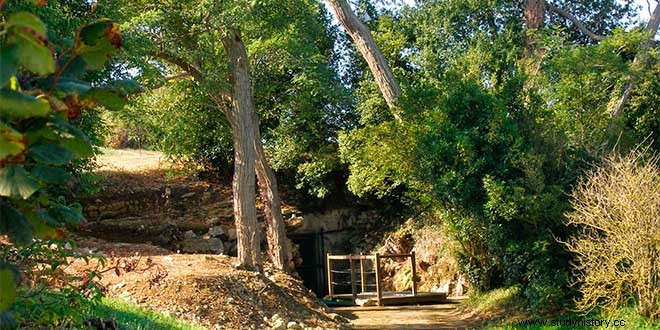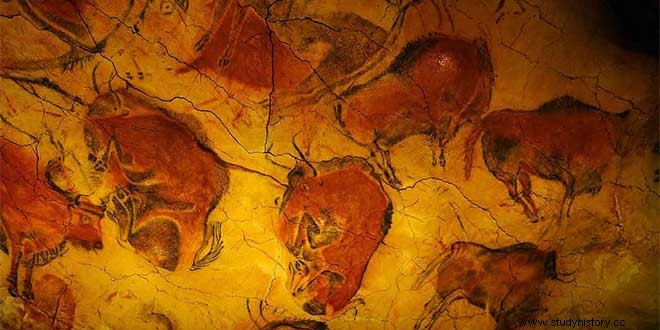The discovery in 1879 by Marcelino Sanz de Sautuola of the paintings in the Altamira Cave , two kilometers from the town of Santillana del Mar in Cantabria, is the most important moment in modern archaeological research and at the time involved a total revision of the perception of the life and customs of human groups up to that time. prehistoric But, despite the fact that legend has wanted its discovery to be accidental, the truth is that Sanz de Sautuola had previously visited the cave, which a hunter's dog had located in 1868, and it was his visit in Paris of the Universal Exhibition of 1878 in which the most recent archaeological finds in France were exhibited, which prompted him to repeat his entry into the cave, this time accompanied by his daughter María.
"Dad, oxen!" They say that little Maria shouted when she, looking at the ceiling of what is now known as the Polychrome Room , she fixed her eyes on the incredible bison that decorate it. From then on, as usually happens with all the great discoveries of humanity, Sanz de Sautuola must have suffered tremendous misunderstanding after publishing his conclusions and was harshly attacked by the leading world specialists of the time.
Only twenty years later, after the paintings of Les Corbarelles and Font de Gâume were discovered in France, the same Cartailhac, who had behaved so harshly with the Spanish researcher, publicly acknowledged his error and vindicated in several conferences the writings of Sanz de Sautuola. Unfortunately he had already passed away, but Cartailhac made it a custom, as a gentlemanly way of apologizing for his evident lack of scientific modesty, every time he visited the cave, to pay his respects to Maria, the true discoverer of the paintings, to his family residence in Puente San Miguel.
The first occupation of the cave occurred in the Solutrean period, about 18,540 years ago, a date that was obtained by doping carbon-14 from an extracted bone at the corresponding level. Various objects were also found from this period, such as notch points, scrapers and burins.
However, the paintings, which are found throughout almost the entire cave, three hundred meters long, belong to less remote times and their creation can be estimated to have occurred between 14,450 and 15,500. Chance did have a great influence on the conservation of the paintings since a landslide sealed the grotto some 13,500 years ago, thus allowing them to reach us. However, the deterioration caused by the massive visits in the 1960s and 1970s has led to the almost total closure of the cave, which is limited to 8,500 visits per year upon written request.

Rour through the Caves of Altamira
The cave art of Altamira, more than one hundred and seventy figures between paintings and engravings, appears in almost all its extension, although several zones can be distinguished. The first of them, the Sala de los Policromos , was originally connected to the living area of the Paleolithic groups, so it is assumed that originally it must have even had natural lighting, although the various landslides and the intervention that Obermaier carried out to avoid them prevent us from having an exact idea of how It was actually. This first room contains a large number of works of art, among which the group of polychrome paintings on its ceiling stand out for their masterful perfection. A total of twenty bison engraved and painted in red and black and measuring between 110 and 170 centimeters; two horses, one with only a large head and the start of the mane; a large bovine head drawn in black; and a huge 2.20 meter long hind, which many consider to be the most beautiful figure in the cave and which contrasts its delicate and expressive head with that of the bovine mentioned above.
On the wall to the right of the room are other possibly older paintings depicting pot-bellied, short-legged horses, ten individuals, a possible moose, and a goat. Two human hands in positive and in red and four negative hands in violet color can also be seen. In addition, a large number of claviform-type signs are observed, more than forty, which even reach the polychrome area, and others in the form of a grill, pectiniform and tectiform.
On the other hand, the same ceiling of the polychromes also presents numerous engravings made with a fine burin of extraordinary delicacy. Five deer, eighteen hinds, five goats, two horses and two cattle, and a motif repeated up to seventy times, like a bundle of stripes that has received the name of huts. Finally, there are at least eight anthropomorphic figures, apparently masked with bird heads and in a praying position. The capital importance of this room is also due to its extension, since the main panel has an extension of eighteen meters diagonally , a measure only comparable to that of the French cave of Lascaux.

But Altamira's art is not just limited to this room. In the second room there are various representations, mainly engraved. On the ceiling are the so-called macaroons, which are figures made with the fingers on the fresh clay, and surrounded by these signs is a beautiful bison head. At the back of the room, on the walls you can see two deer, a horse and a bison, all of them very schematic. And to the left there is a frieze where an engraved hind can be seen, with grooves on the inside looking for shading, a detached block on the floor with several horses and deer, and a good collection of engravings, among which three hind heads stand out. a complete horse, two stags with antlers and four more hinds. Continuing down the gallery, you can see an engraved bull on the left and next to it a chamois head.
A little further on, there is a black bison superimposed on a horse, with which it shares part of its outline, and two goats. At the end of the gallery there is a large room with a chamber called La Hoya, to which one descends through a stream of stalagmites. Inside there is a figure of a bison in black and a panel with a doe's head in black, very similar to the great doe of the Polychromes, and various figures of goats.
From here on, no more paintings can be found until the end of the cave, in a narrow gallery called Cola de Caballo. On its ceiling again appear a large number of signs made with the fingers in no apparent order and the first figures we find are a bison, a horse, a bovine head and various engravings of cervids. Next, techniform signs appear before reaching the center of the room, where there is a mask made taking advantage of the natural relief to which the eyes and mouth have been added, in front of an impressive natural mask that resembles a human face. The most curious thing about this room is that standing in the center of it one finds one with these masks and towards the exits of the room they are cut by other painted masks, which suggests that this arrangement is not the result of chance and suggests ancient initiation rituals, since throughout the cave there are many rocks that could be turned into masks and were not.
The visit to the Altamira cave today is, as has already been warned, an undertaking that requires patience; however, the new Altamira Museum, inaugurated next to it in 2001, presents, in addition to the excellent replica of the polychrome ceiling that Pedro Saura and Matilde Múzquiz have made, an important collection of the materials found in the different excavations of the site, exhibited in a which helps to understand how extraordinary this site is for understanding the history of mankind.
